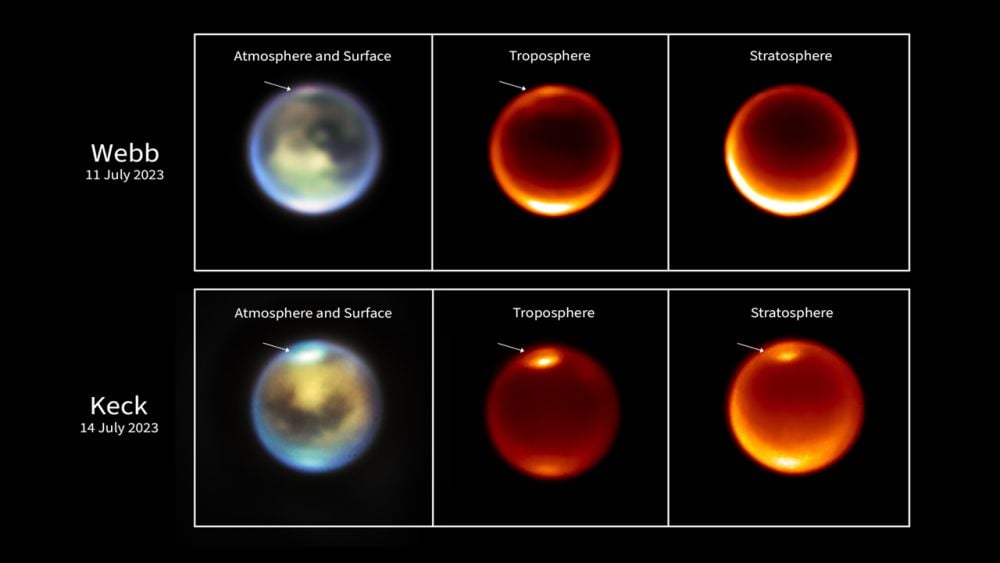Saturn's moon Titan is the only other body in the Solar System with weather similar to Earth's. The large moon has a thick, nitrogen-rich atmosphere like Earth's, liquid on its surface, and a precipitation cycle. But instead of water, the surface liquid and the precipitation cycle are mainly based on methane.
Planetary scientists have questions about Titan's methane cycle, especially regarding the moon's northern hemisphere, where its hydrocarbon lakes are concentrated. The Cassini-Huygens mission examined that region during its mission, but left many questions unanswered. Titan's year lasts 29.45 Earth years, so the northern hemisphere experienced winter and spring the entire time that Cassini-Huygens was there.
In new research, scientists used the JWST and the Keck II telescope to observe Titan during 2022 and 2023, when the moon's northern hemisphere was experiencing summer. They gained new insights into Titan's methane cycle and other aspects of its atmosphere.
The research, published in Nature Astronomy, is titled "The atmosphere of Titan in late northern summer from JWST and Keck observations." The lead author is Conor Nixon, a planetary scientist from the Planetary Systems Laboratory at NASA Goddard Space Flight Center.
Titan has a thick atmosphere, and it's the only moon in the Solar System with one. Due to its cold surface and troposphere, methane can condense in the moon's lower atmosphere. "Methane therefore plays a similar meteorological role to water on Earth, evaporating from the surface and reaching the middle troposphere, where methane clouds form and rainfall occurs in changing seasonal patterns," the researchers explain in their article.
 *Titan is known for its thick, nitrogen-rich atmosphere, as seen in this true-colour Cassini image. Image Credit: NASA/JPL-Caltech/SSI/Kevin M. Gill*
*Titan is known for its thick, nitrogen-rich atmosphere, as seen in this true-colour Cassini image. Image Credit: NASA/JPL-Caltech/SSI/Kevin M. Gill*
"Titan is the only other place in our solar system that has weather like Earth, in the sense that it has clouds and rainfall onto a surface," Nixon explained in a press release.
In both worlds, convection drives the cycle. The Sun heats the surface and causes methane, or water in Earth's case, to evaporate and rise in the atmosphere. The temperature drops at higher elevations, and the vapour condenses and falls as rain.
"Together, these results provide a new, integrated look at the composition and meteorology of Titan's atmosphere in 2022 and 2023 from the upper atmosphere to the surface, at a season that was poorly documented by previous observations," the authors write in their research article.
One of the key questions facing scientists who study Titan's atmosphere concerns how the methane cycle changes through the seasons in different hemispheres. In this research, Nixon and his colleagues used the JWST's Mid-Infrared Instrument (MIRI) to detect the methyl radical CH~3~. CH~3~has lost one of its hydrogen atoms and has an unpaired electron. That unpaired electron makes the radical highly reactive, and it typically has a very short lifetime because of it. CH~3~is the main product of methane breakup in Titan's atmosphere, and is also the key to forming ethane and other heavier molecules like hydrogen cyanide (HCN) and acetylene (C~2~H~2~).
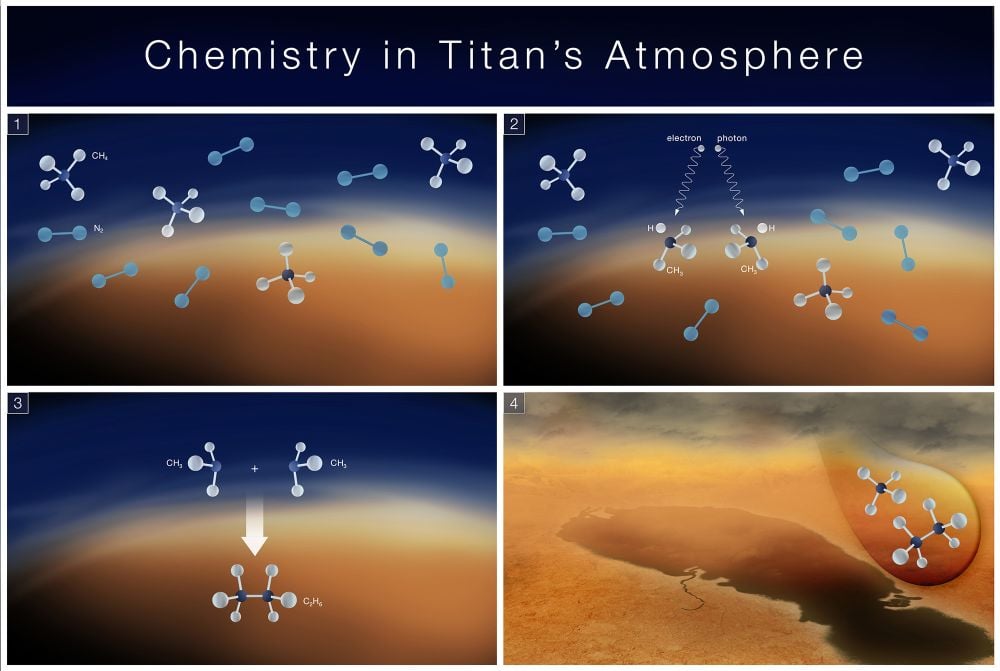 JWST observations show how the methane cycle works in Titan's atmosphere. The moon has a thick, nitrogen-rich atmosphere that also contains methane. Sunlit and energetic protons from Saturn split apart methane, forming the methane radical CH~3~. CH~3~is highly reactive and rapidly combines with other molecules or other CH~3~molecules, forming molecules like ethane (C~2~H~6~). Then methane, ethane, and other molecules precipitate out of the atmosphere and fall as liquids onto Titan's surface, where they collect in the northern hemisphere's lakes. Image Credit: NASA, ESA, CSA, Elizabeth Wheatley (STScI)
JWST observations show how the methane cycle works in Titan's atmosphere. The moon has a thick, nitrogen-rich atmosphere that also contains methane. Sunlit and energetic protons from Saturn split apart methane, forming the methane radical CH~3~. CH~3~is highly reactive and rapidly combines with other molecules or other CH~3~molecules, forming molecules like ethane (C~2~H~6~). Then methane, ethane, and other molecules precipitate out of the atmosphere and fall as liquids onto Titan's surface, where they collect in the northern hemisphere's lakes. Image Credit: NASA, ESA, CSA, Elizabeth Wheatley (STScI)
They used the JWST's Near-Infrared Spectrograph to detect CO and CO2 emission bands and measured these species over a wide range of altitudes. They also used the infrared cameras on the JWST and the Keck II to image tropospheric clouds over the northern hemisphere as they evolved by altitude. Scientists have observed clouds rising convectively over the southern hemisphere, but never over the northern hemisphere.
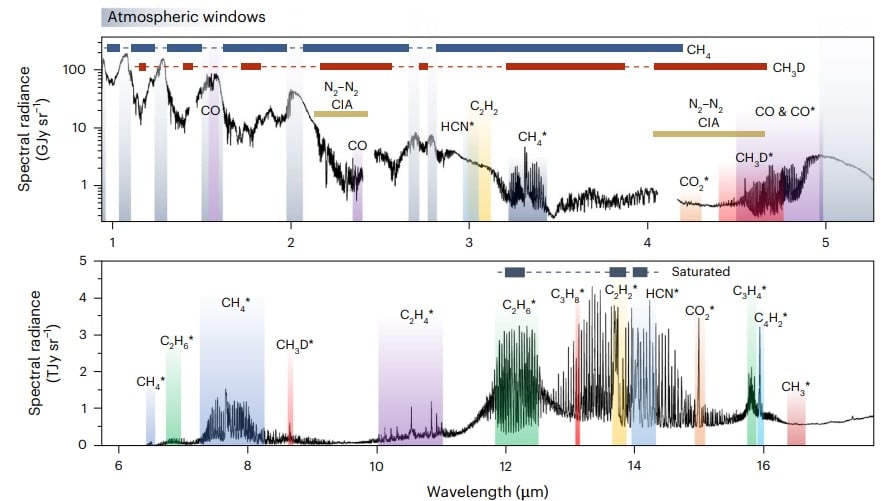 This figure from the research shows the JWST's spectroscopy results from NIRSpec (top) and MIRI (bottom). Grey bands in the top image show Titan's atmospheric windows. Note the detection of CH~3~in the MIRI data, the first definitive detection of the methane radical in the moon's atmosphere. Image Credit: Nixon et al. 2025, Nature Astronomy.
This figure from the research shows the JWST's spectroscopy results from NIRSpec (top) and MIRI (bottom). Grey bands in the top image show Titan's atmospheric windows. Note the detection of CH~3~in the MIRI data, the first definitive detection of the methane radical in the moon's atmosphere. Image Credit: Nixon et al. 2025, Nature Astronomy.
This is significant because Titan's methane seas are concentrated in the northern hemisphere. This research shows how the seas can be the source of methane evaporation that fuels the moon's methane cycle.
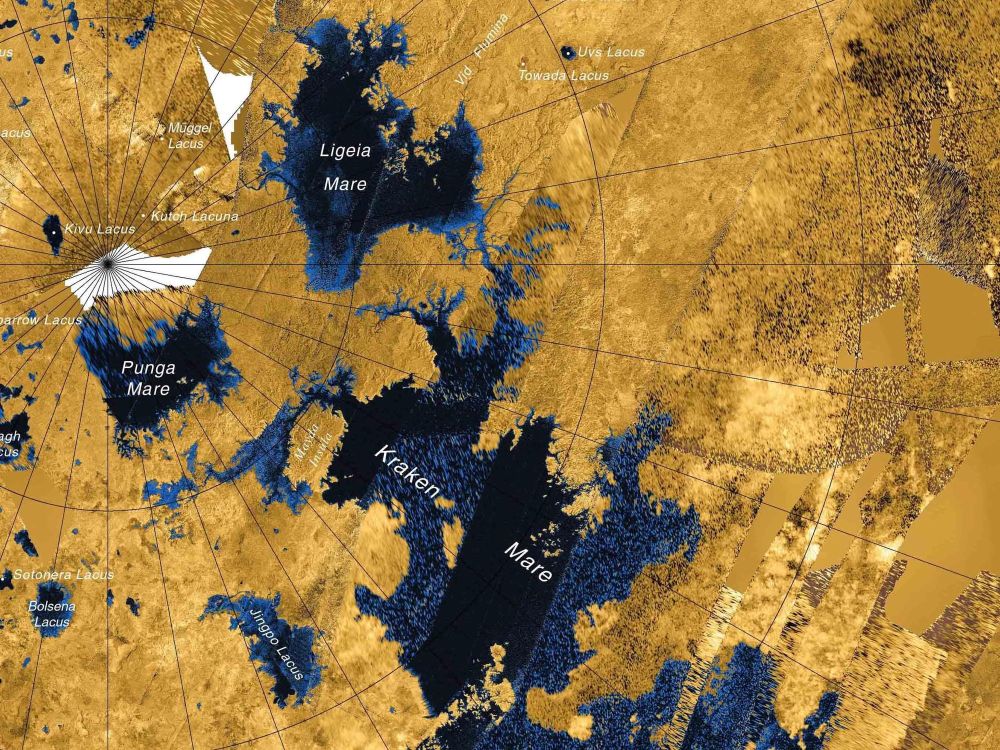 Titan's lakes or seas are concentrated in the northern hemisphere and have about the same surface area as the Great Lakes. Image Credit: NASA / JPL-Caltech / Agenzia Spaziale Italiana / USGS, Public Domain.
Titan's lakes or seas are concentrated in the northern hemisphere and have about the same surface area as the Great Lakes. Image Credit: NASA / JPL-Caltech / Agenzia Spaziale Italiana / USGS, Public Domain.
This isn't the first time scientists have observed clouds in Titan's atmosphere, but it's the first time observations have revealed such powerful convection.
"Our new observations of methane clouds in Titan's troposphere during late northern summer on Titan add to a catalogue of previous detections recorded by ground- and space-based observations that trace the seasonal variation of Titan's weather over nearly a full year," the authors write. Cassini detected many clouds in the southern hemisphere, and ground-based telescopes have observed large cloud outbursts in the same region.
In the last summer solstice in the northern hemisphere in 2017, clouds were increasingly being detected, "but few indicated deep, moist convection," the authors write. "Our observations indicate a continuation of cloud activity into late northern summer, roughly in agreement with the behaviour at high southern latitudes during southern summer, and also indicate the occurrence of deep, moist convection extending to the tropopause over the region of Titan where most of the surface liquids exist," they explain.
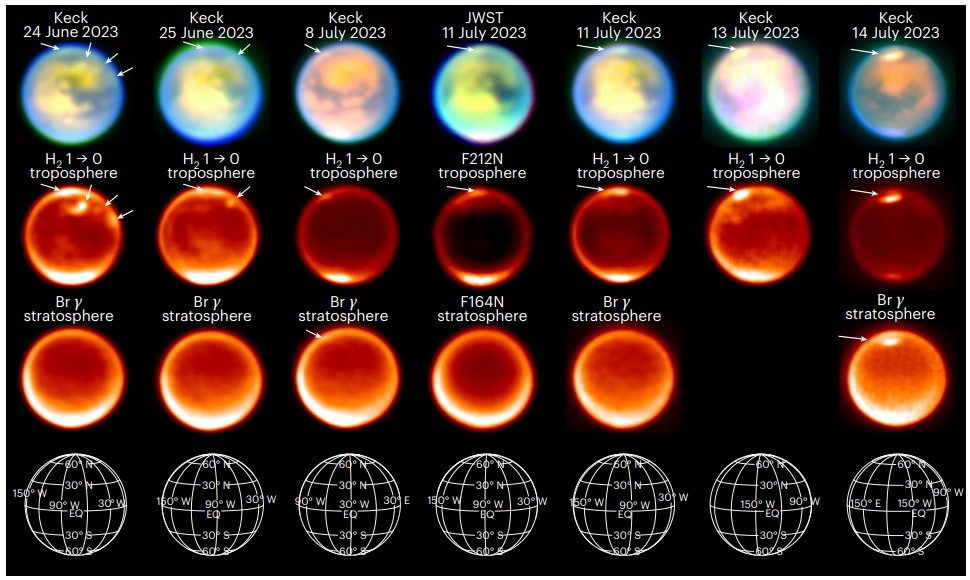 This figure from the research article shows how clouds were detected over Titan's northern hemisphere. Arrows show the clouds as they change over time. Image Credit: Nixon et al. 2025, Nature Astronomy.
This figure from the research article shows how clouds were detected over Titan's northern hemisphere. Arrows show the clouds as they change over time. Image Credit: Nixon et al. 2025, Nature Astronomy.
The research also examines what these new insights into Titan's atmosphere could mean for its future.
When methane breaks up in Titan's atmosphere, some of it joins with other molecules and falls back to the surface; however, some hydrogen escapes into space. That means that without constant methane replenishment from some source, Titan's atmosphere will deplete methane over time. This happened on Mars, which is now a cold, dry world.
"On Titan, methane is a consumable. It's possible that it is being constantly resupplied and fizzing out of the crust and interior over billions of years. If not, eventually it will all be gone and Titan will become a mostly airless world of dust and dunes," said lead author Nixon.
Press Release:Webb's Titan Forecast: Partly Cloudy With Occasional Methane Showers
Research:The atmosphere of Titan in late northern summer from JWST and Keck observations
 Universe Today
Universe Today
